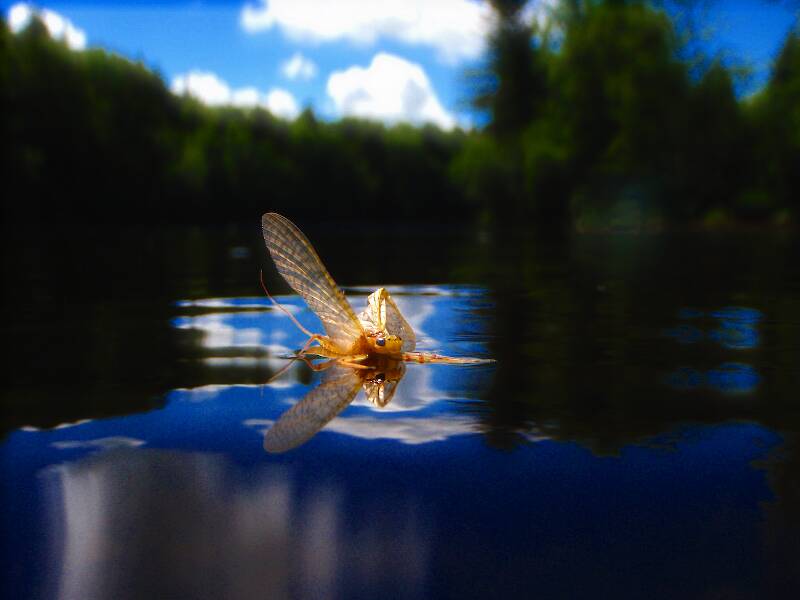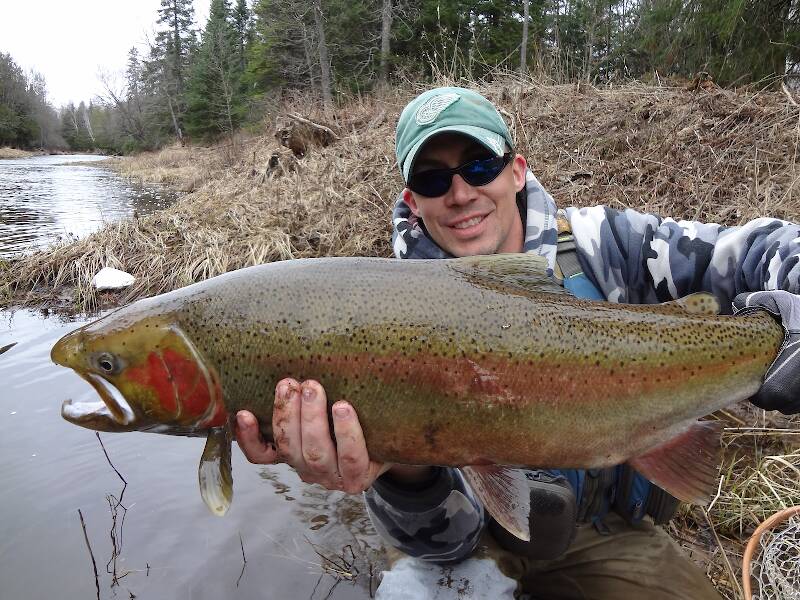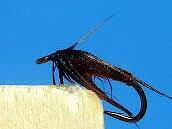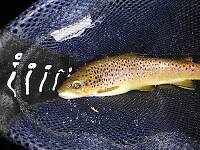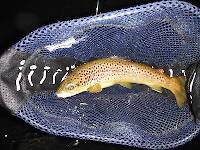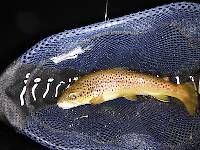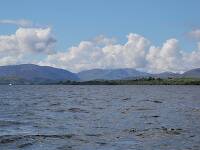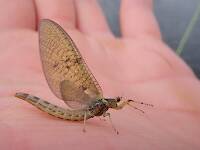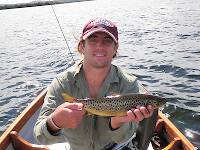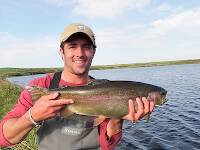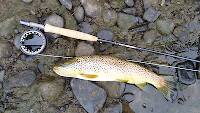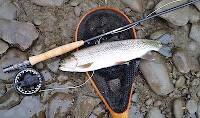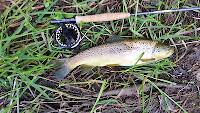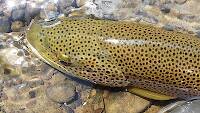
Salmonflies
Pteronarcys californica
The giant Salmonflies of the Western mountains are legendary for their proclivity to elicit consistent dry-fly action and ferocious strikes.
Featured on the forum

This specimen appears to be of the same species as this one collected in the same spot two months earlier. The identification of both is tentative. This one suffered some physical damage before being photographed, too, so the colors aren't totally natural. I was mostly photographing it to test out some new camera setting idea, which worked really well for a couple of closeups.

Troutnut is a project started in 2003 by salmonid ecologist Jason "Troutnut" Neuswanger to help anglers and
fly tyers unabashedly embrace the entomological side of the sport. Learn more about Troutnut or
support the project for an enhanced experience here.
Al514 on Mar 18, 2008March 18th, 2008, 1:37 am EDT
I have posted about this topic before a whlie back, but am curious about something else now. The easiest way for me to tell if a brown is wild, is the blue spot behind the eye (anyone look for something else?). Having just about completed my first winter of fly fishing, I have noticed that some of the browns I have been catching display this blue spot and others don't. The streams I fish aren't stocked so there is no possibility of a stockie. Do the colors simply fade in the winter? Is this a sub-species of a brown? In the summer, all of the browns from the same streams have an obvious blue spot behind the eye and some even have two. Its very interesting to see the different colorings on these fish and if anyone can shed some light on the subject, I would appreciate it.
Mtskibum on Mar 18, 2008March 18th, 2008, 5:16 am EDT
I dont think that a dot shows if a brown is stocked or not. There was a post i was reading that said that in PA, stocked trout had less coloration for the first 6 months, but after 6 months it was impossible for even Fish and wildlife officials to tell if a fish was stocked or not without a microscope.
Sayfu
Posts: 560
Posts: 560
Sayfu on Oct 13, 2012October 13th, 2012, 7:05 am EDT
Aren't there two distinct species of browns? My memory has no chance of recalling them unless I start googling.
Pryal74 on Oct 13, 2012October 13th, 2012, 1:36 pm EDT
There are 2 different types of Brown Trout. The blue dot behind the eye is found in both if I am remembering right.
The blueish hue behind the eye becomes more prominent the longer the fish is wild. If it is born wild, it will show up much earlier, than a stocked fish. BUT! A stocked fish, with a few seasons in the river or lake, can develop it.
You will also notice red or red spots on the adipose fin.
Another way to tell a wild trout compared to a hatchery or planted fish is fuller and more developed fins. You will notice on hatchery fish they have small, clipped or underdeveloped fins. A wild trout will have full, round and robust fin. The reasoning behind this is... a hatchery fish will not experience varying currents or sometimes no current. A wild trout will have lived in currents it's entire life.
You can sometimes notice a big difference in the overall coloration or lack thereof in planted/stocked/hatchery raised Brown Trout. Wild or older river resident trout with have bolder patterns. The red spots or even the halos will show far better at times. The larger and more wild browns will have a deeper gold color as well.
Hope this helps. I am by no means an expert, this is just what I have observed or learned from my experience in the field and with my father's Ichthyology books.
The blueish hue behind the eye becomes more prominent the longer the fish is wild. If it is born wild, it will show up much earlier, than a stocked fish. BUT! A stocked fish, with a few seasons in the river or lake, can develop it.
You will also notice red or red spots on the adipose fin.
Another way to tell a wild trout compared to a hatchery or planted fish is fuller and more developed fins. You will notice on hatchery fish they have small, clipped or underdeveloped fins. A wild trout will have full, round and robust fin. The reasoning behind this is... a hatchery fish will not experience varying currents or sometimes no current. A wild trout will have lived in currents it's entire life.
You can sometimes notice a big difference in the overall coloration or lack thereof in planted/stocked/hatchery raised Brown Trout. Wild or older river resident trout with have bolder patterns. The red spots or even the halos will show far better at times. The larger and more wild browns will have a deeper gold color as well.
Hope this helps. I am by no means an expert, this is just what I have observed or learned from my experience in the field and with my father's Ichthyology books.
-James Pryal
Into The Wild Fly Fishing
Into The Wild Fly Fishing
DUBBN on Oct 13, 2012October 13th, 2012, 2:07 pm EDT
I will take your word for the red spot on the adipose fin. The Browns have not been stocked on the lower Gunnison river in generations. Yet, from my observations there are no red spots on the adipose fin in the lower drainage of this river.
"2 different" types? After 30 to 50 years would these "species" have not inner bred?
I have a really hard time saying a Brown Trout is wild due to its red spot on the adipose fin (or lack there of). You made it easyer now that I can refer nonbelievers to you and your dad.
"2 different" types? After 30 to 50 years would these "species" have not inner bred?
I have a really hard time saying a Brown Trout is wild due to its red spot on the adipose fin (or lack there of). You made it easyer now that I can refer nonbelievers to you and your dad.
It's OK to disagree with me. I can not force you to be right.
Pryal74 on Oct 13, 2012October 13th, 2012, 4:30 pm EDT
I am sure it can vary in all places of the world. All trout take on different patterns, shades, coloration, spots and other various markings etc. This can all be due to the content of the water, temps, cover and a host of other variables.
-James Pryal
Into The Wild Fly Fishing
Into The Wild Fly Fishing
DUBBN on Oct 13, 2012October 13th, 2012, 4:57 pm EDT
I am sure it can vary in all places of the world. All trout take on different patterns, shades, coloration, spots and other various markings etc. This can all be due to the content of the water, temps, cover and a host of other variables.
Spots are totally genetic. They are just like finger prints to humans. No two fish have identical spots.
Sure wish you would have mentioned your last post in the previous thread.
It's OK to disagree with me. I can not force you to be right.
Quick Reply
Related Discussions
Topic
Replies
Last Reply
0
Sep 20, 2013
by Jmd123
by Jmd123


